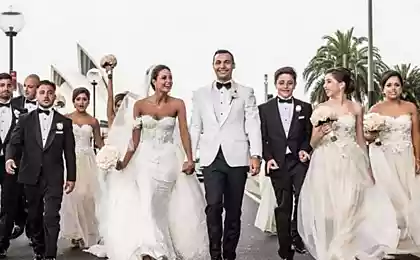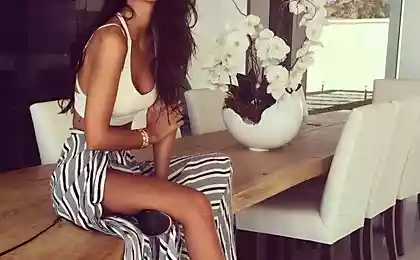620
The whole truth about the garden lanterns with solar batteries
We measured the power consumption of street garden lanterns with solar batteries, as well as the charging rate in direct sunlight, on a cloudy day or in the shade. The painting was interesting, although it is expected.

This article talks about is not so much the specific flashlights as generally about the practical side of the work lamps with solar batteries.
For the experiment, we took two inexpensive flashlight on solar batteries. One of them is a relatively new type (brown pictured), of which there are now on sale at the price from 40 to 150 rubles. absolute majority. Second (Black pictured) - the old model, which at the same densely populated store shelves for the same price a few years ago
.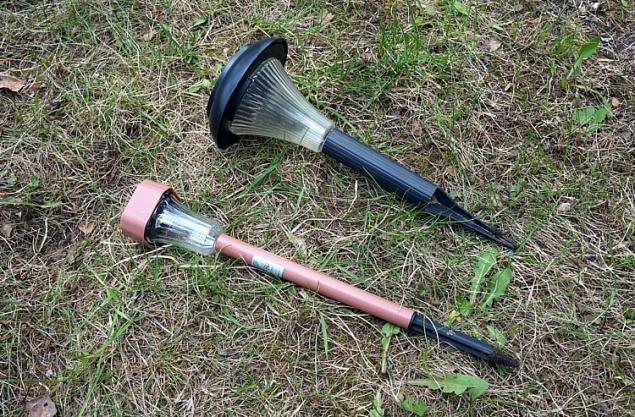
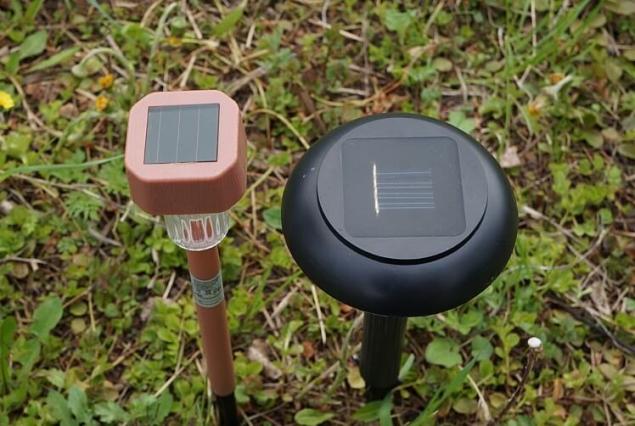
The main difference in the Solar Lantern. And here and there it is a film type, but from different materials. Also old lantern was installed Ni-MH battery capacity AA 600 mAh, whereas it is in the new smaller (AAA) and the total capacity of 100 mAh. It is a natural reduction in price, due to which the price of these lanterns after the jump of the dollar has not changed so much.

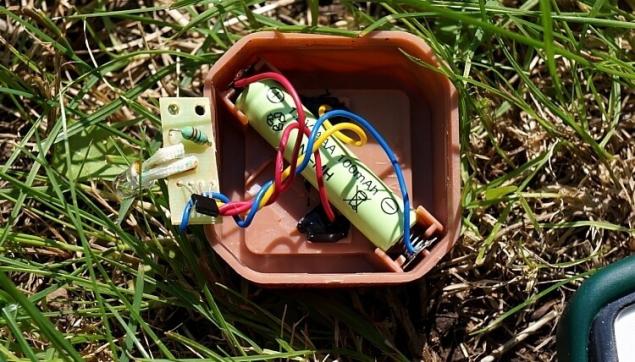
Consumption of both LEDs in flashlights were the same and amounted to about 12 mA (~ 14 MWh). This means that when fully charged new flashlight be able to work 8-9 hours, and the old (only in theory) 45-50. But here it is important to remember that working in conditions of constant undercharge (more on this below) Ni-MH rechargeable batteries quickly lose their capacity because more capacious battery in the old flashlight would have been preferable only from the point of view that it would be spent for a year longer.
Now let's deal with power panels and charging.
Efficiency solar charging
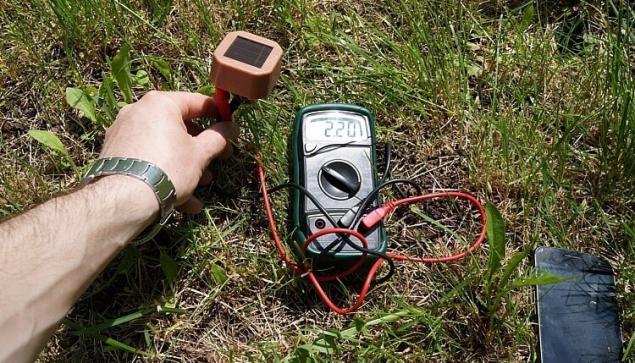
To assess the effectiveness of the charge in different conditions, we have chosen a good day: the sun, which at times was closed by small light clouds. Lanterns were placed both in the open and in the shade of garden trees. The voltage and current were measured at the battery terminals. The values obtained, we were transferred to the amount of energy produced, expressed in MWh. That's what we've got:
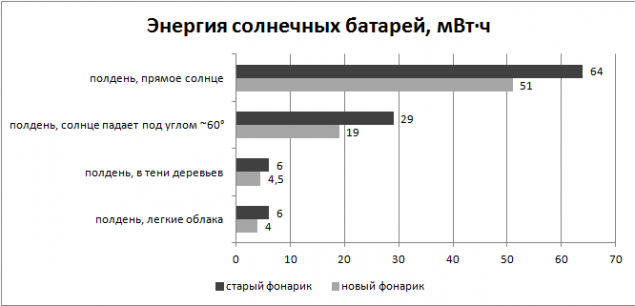
solar power from the old flashlight was considerably higher, but this is not so interesting. More importantly, and this is good news that in direct sunlight small battery in the new torch able to fully charged in about 2, 5-3 hours. And now the bad news. If the flashlight is placed in the shade or the day was a bit cloudy, the charging efficiency drops by 10 times. And if the sky clouds, and then there is not much to talk about. The battery will not charge.
For those who are interested in the details of our measurement performance of solar cells, is a small plate.
the conditions of the solar battery flashlight new old flashlight
noon direct sun 2, 21 V, 23 mA, 2, 06 V, 31 mA
midday sun is at an angle of ~ 60 ° 2 08 B 9 1 mA, 95 V, 15 mA
noon light clouds 1, 92 B, 2, 1, 0 mA, 8, 3, 1 mA
noon, in the shade of trees 1, 85 B 2, 1, 5 mA, 85 V, 3, 4 mA
Conclusions
Lanterns have proved quite workable. The new model is able to direct sunlight to fully charge the internal battery in approximately 3 hours, which is enough to run the built-in LED for 8-9 hours. old-style model is more powerful and has a more capacious battery, but there is no reason for her sense because Sales of these can not be found.
Another important point is that the efficiency of solar work in cloudy weather drops 10 times. A charge in cloudy and does terminate. The same can be said about placing torches in the shade where sunny weather provided for a light day, they will not be able to charge your battery even a small half, and in the presence of a light cloud cover charge at all stops.

This article talks about is not so much the specific flashlights as generally about the practical side of the work lamps with solar batteries.
For the experiment, we took two inexpensive flashlight on solar batteries. One of them is a relatively new type (brown pictured), of which there are now on sale at the price from 40 to 150 rubles. absolute majority. Second (Black pictured) - the old model, which at the same densely populated store shelves for the same price a few years ago
.


The main difference in the Solar Lantern. And here and there it is a film type, but from different materials. Also old lantern was installed Ni-MH battery capacity AA 600 mAh, whereas it is in the new smaller (AAA) and the total capacity of 100 mAh. It is a natural reduction in price, due to which the price of these lanterns after the jump of the dollar has not changed so much.


Consumption of both LEDs in flashlights were the same and amounted to about 12 mA (~ 14 MWh). This means that when fully charged new flashlight be able to work 8-9 hours, and the old (only in theory) 45-50. But here it is important to remember that working in conditions of constant undercharge (more on this below) Ni-MH rechargeable batteries quickly lose their capacity because more capacious battery in the old flashlight would have been preferable only from the point of view that it would be spent for a year longer.
Now let's deal with power panels and charging.
Efficiency solar charging

To assess the effectiveness of the charge in different conditions, we have chosen a good day: the sun, which at times was closed by small light clouds. Lanterns were placed both in the open and in the shade of garden trees. The voltage and current were measured at the battery terminals. The values obtained, we were transferred to the amount of energy produced, expressed in MWh. That's what we've got:

solar power from the old flashlight was considerably higher, but this is not so interesting. More importantly, and this is good news that in direct sunlight small battery in the new torch able to fully charged in about 2, 5-3 hours. And now the bad news. If the flashlight is placed in the shade or the day was a bit cloudy, the charging efficiency drops by 10 times. And if the sky clouds, and then there is not much to talk about. The battery will not charge.
For those who are interested in the details of our measurement performance of solar cells, is a small plate.
the conditions of the solar battery flashlight new old flashlight
noon direct sun 2, 21 V, 23 mA, 2, 06 V, 31 mA
midday sun is at an angle of ~ 60 ° 2 08 B 9 1 mA, 95 V, 15 mA
noon light clouds 1, 92 B, 2, 1, 0 mA, 8, 3, 1 mA
noon, in the shade of trees 1, 85 B 2, 1, 5 mA, 85 V, 3, 4 mA
Conclusions
Lanterns have proved quite workable. The new model is able to direct sunlight to fully charge the internal battery in approximately 3 hours, which is enough to run the built-in LED for 8-9 hours. old-style model is more powerful and has a more capacious battery, but there is no reason for her sense because Sales of these can not be found.
Another important point is that the efficiency of solar work in cloudy weather drops 10 times. A charge in cloudy and does terminate. The same can be said about placing torches in the shade where sunny weather provided for a light day, they will not be able to charge your battery even a small half, and in the presence of a light cloud cover charge at all stops.
Volvo starts production of cars with autopilot highways by 2021
Vadim Zeland: How to reverse the aging process






















